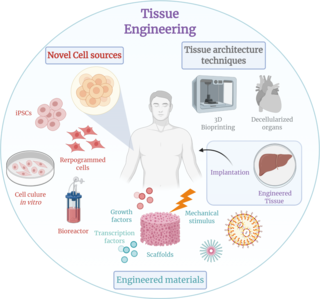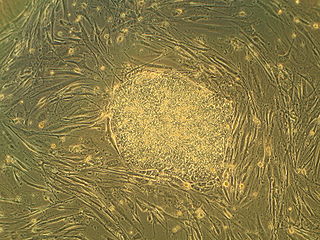
Biomedical engineering (BME) or medical engineering is the application of engineering principles and design concepts to medicine and biology for healthcare applications. BME is also traditionally logical sciences to advance health care treatment, including diagnosis, monitoring, and therapy. Also included under the scope of a biomedical engineer is the management of current medical equipment in hospitals while adhering to relevant industry standards. This involves procurement, routine testing, preventive maintenance, and making equipment recommendations, a role also known as a Biomedical Equipment Technician (BMET) or as a clinical engineer.

Tissue engineering is a biomedical engineering discipline that uses a combination of cells, engineering, materials methods, and suitable biochemical and physicochemical factors to restore, maintain, improve, or replace different types of biological tissues. Tissue engineering often involves the use of cells placed on tissue scaffolds in the formation of new viable tissue for a medical purpose, but is not limited to applications involving cells and tissue scaffolds. While it was once categorized as a sub-field of biomaterials, having grown in scope and importance, it can be considered as a field of its own.

Regenerative medicine deals with the "process of replacing, engineering or regenerating human or animal cells, tissues or organs to restore or establish normal function". This field holds the promise of engineering damaged tissues and organs by stimulating the body's own repair mechanisms to functionally heal previously irreparable tissues or organs.
Neural engineering is a discipline within biomedical engineering that uses engineering techniques to understand, repair, replace, or enhance neural systems. Neural engineers are uniquely qualified to solve design problems at the interface of living neural tissue and non-living constructs.
Peter W. Zandstra, is a Canadian scientist who is the Director of the Michael Smith Laboratories at the University of British Columbia.

Anthony Atala is an American bioengineer, urologist, and pediatric surgeon. He is the W.H. Boyce professor of urology, the founding director of the Wake Forest Institute for Regenerative Medicine, and the chair of the Department of Urology at Wake Forest School of Medicine in North Carolina. His work focuses on the science of regenerative medicine: "a practice that aims to refurbish diseased or damaged tissue using the body's own healthy cells".

Sangeeta N. Bhatia is an American biological engineer and the John J. and Dorothy Wilson Professor at MIT’s Institute for Medical Engineering and Science and Electrical Engineering and Computer Science (EECS) at the Massachusetts Institute of Technology (MIT) in Cambridge, Massachusetts, United States. Bhatia's research investigates applications of micro- and nano-technology for tissue repair and regeneration. She applies ideas from computer technology and engineering to the design of miniaturized biomedical tools for the study and treatment of diseases, in particular liver disease, hepatitis, malaria and cancer.
Kristi S. Anseth is the Tisone Distinguished Professor of Chemical and Biological Engineering, an Associate Professor of Surgery, and a Howard Hughes Medical Investigator at the University of Colorado at Boulder. Her main research interests are the design of synthetic biomaterials using hydrogels, tissue engineering, and regenerative medicine.

Gordana Vunjak-NovakovicFRSC is a Serbian American biomedical engineer and university professor. She is a University Professor at Columbia University, as well as the Mikati Foundation Professor of Biomedical Engineering and Medical Sciences. She also heads the laboratory for Stem Cells and Tissue Engineering at Columbia University. She is part of the faculty at the Irving Comprehensive Cancer Center and the Center for Human Development, both found at Columbia University. She is also an honorary professor at the Faculty of Technology and Metallurgy at the University of Belgrade, an honorary professor at the University of Novi Sad, and an adjunct professor at the Department of Biomedical Engineering at Tufts University.
EpiBone is a biomedical engineering company that is developing technology to create bone tissue from a patient's mesenchymal stem cells in vitro for use in bone grafts. The company was founded by Nina Tandon and Sarindr “Ik” Bhumiratana.
Treena Livingston Arinzeh is an American biomedical engineer and academic.
Irene Rena Bizios is an American bioengineer. She is the Peter Flawn Professor at University of Texas at San Antonio and the Lutcher Brown Chair Professor in the Department of Biomedical Engineering. Bizios is an Elected Fellow of the National Academy of Medicine, National Academy of Inventors, American Academy of Arts and Sciences, National Academy of Engineering, and American Institute of Chemical Engineers. Her current interests are cellular and tissue engineering, biocompability and tissue-biomaterial relationships.
Sridevi Sarma is an American biomedical and electrical engineer known for her work in applying control theory to improve therapies for neurological disorders such as Parkinson's disease and epilepsy. She is vice dean for graduate education of the Johns Hopkins University Whiting School of Engineering, associate director of the Johns Hopkins Institute for Computational Medicine, and an associate professor in the Johns Hopkins Department of Biomedical Engineering.
Laura Elizabeth Niklason is a physician, professor and internationally recognized researcher in vascular and lung tissue engineering. She is the Nicholas M. Greene Professor of Anesthesiology and Biomedical Engineering at Yale University and co-founder, chief executive officer and president of Humacyte, a regenerative medicine company developing bioengineered human tissues.

Christine P. Hendon is an electrical engineer and computer scientist and an associate professor in the Department of Electrical Engineering at Columbia University in New York City. Hendon is a pioneer in medical imaging. She develops biomedical optics technologies, using optical coherence tomography and near infrared spectroscopy systems, that enable physicians to perform guided interventional procedures and allow for structure-function dissection of human tissues and organs. Her advances in imaging technologies have led to improved diagnostic abilities and treatments for cardiac arrhythmias as well as breast cancer and preterm birth. She has been recognized for her development of optical imaging catheters for cardiac wall imaging by Forbes 30 under 30, the MIT Technology Review’s 35 Innovators Under 35, and by President Obama with the Presidential Early Career Awards in 2017.

Milica Radisic is a Serbian Canadian tissue engineer, academic and researcher. She is a professor at the University of Toronto’s Institute of Biomaterials and Biomedical Engineering, and the Department of Chemical Engineering and Applied Chemistry. She co-founded TARA Biosystems and is a senior scientist at the Toronto General Hospital Research Institute.
Christine E. Schmidt is an American biomedical engineer. As a professor at the University of Florida, Schmidt was inducted into the Florida Inventors Hall of Fame for her creation of the Avance Nerve Graft which has "improved the lives of numerous patients suffering from peripheral nerve damage." In 2024, Schmidt was elected to both the National Academy of Engineering and the National Academy of Medicine.
Erika Moore Taylor is a biomedical engineer, scientist, assistant professor, "Forbes 30 under 30 honoree," financial advisor, and the founder of a scholarship program that has been featured on CNBC.
Alyssa Panitch is an American biomedical engineer. She is a Professor and Department Chair in the Wallace H. Coulter Department of Biomedical Engineering at Georgia Tech and Emory University. Panitch focuses on designing biopolymers that improve tissue healing and regeneration by researching intracellular and extracellular approaches to direct molecular and cellular processes.
Claudia Fischbach is a German bioengineer who serves as the James M. and Marsha McCormick Director of Biomedical Engineering and the Stanley Bryer 1946 Professor of Biomedical Engineering at Cornell University. She is Director of the Cornell Physical Sciences Oncology Center on the Physics of Cancer Metabolism.








